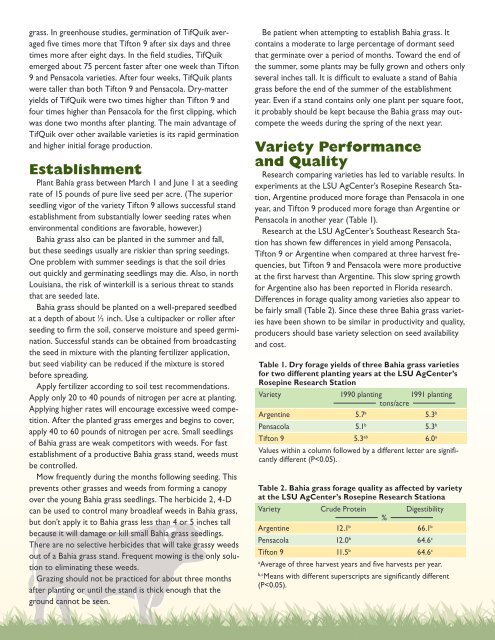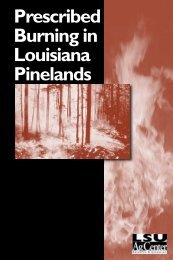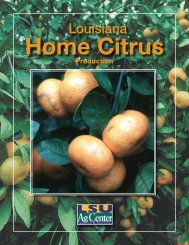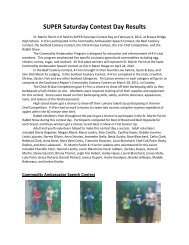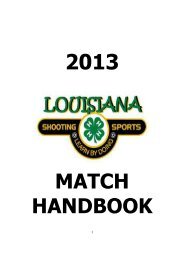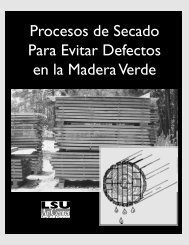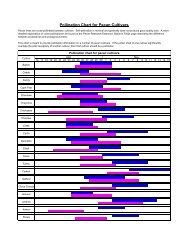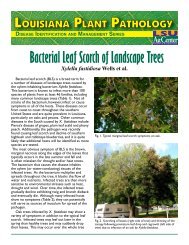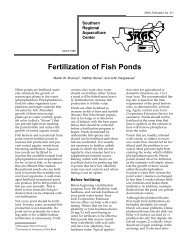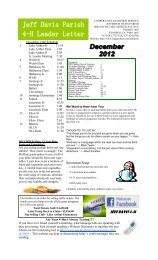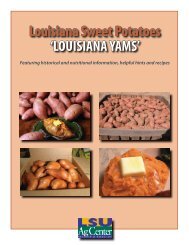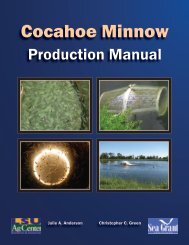Variety Descriptions - The LSU AgCenter
Variety Descriptions - The LSU AgCenter
Variety Descriptions - The LSU AgCenter
You also want an ePaper? Increase the reach of your titles
YUMPU automatically turns print PDFs into web optimized ePapers that Google loves.
grass. In greenhouse studies, germination of TifQuik averaged<br />
five times more that Tifton 9 after six days and three<br />
times more after eight days. In the field studies, TifQuik<br />
emerged about 75 percent faster after one week than Tifton<br />
9 and Pensacola varieties. After four weeks, TifQuik plants<br />
were taller than both Tifton 9 and Pensacola. Dry-matter<br />
yields of TifQuik were two times higher than Tifton 9 and<br />
four times higher than Pensacola for the first clipping, which<br />
was done two months after planting. <strong>The</strong> main advantage of<br />
TifQuik over other available varieties is its rapid germination<br />
and higher initial forage production.<br />
Establishment<br />
Plant Bahia grass between March 1 and June 1 at a seeding<br />
rate of 15 pounds of pure live seed per acre. (<strong>The</strong> superior<br />
seedling vigor of the variety Tifton 9 allows successful stand<br />
establishment from substantially lower seeding rates when<br />
environmental conditions are favorable, however.)<br />
Bahia grass also can be planted in the summer and fall,<br />
but these seedings usually are riskier than spring seedings.<br />
One problem with summer seedings is that the soil dries<br />
out quickly and germinating seedlings may die. Also, in north<br />
Louisiana, the risk of winterkill is a serious threat to stands<br />
that are seeded late.<br />
Bahia grass should be planted on a well-prepared seedbed<br />
at a depth of about ½ inch. Use a cultipacker or roller after<br />
seeding to firm the soil, conserve moisture and speed germination.<br />
Successful stands can be obtained from broadcasting<br />
the seed in mixture with the planting fertilizer application,<br />
but seed viability can be reduced if the mixture is stored<br />
before spreading.<br />
Apply fertilizer according to soil test recommendations.<br />
Apply only 20 to 40 pounds of nitrogen per acre at planting.<br />
Applying higher rates will encourage excessive weed competition.<br />
After the planted grass emerges and begins to cover,<br />
apply 40 to 60 pounds of nitrogen per acre. Small seedlings<br />
of Bahia grass are weak competitors with weeds. For fast<br />
establishment of a productive Bahia grass stand, weeds must<br />
be controlled.<br />
Mow frequently during the months following seeding. This<br />
prevents other grasses and weeds from forming a canopy<br />
over the young Bahia grass seedlings. <strong>The</strong> herbicide 2, 4-D<br />
can be used to control many broadleaf weeds in Bahia grass,<br />
but don’t apply it to Bahia grass less than 4 or 5 inches tall<br />
because it will damage or kill small Bahia grass seedlings.<br />
<strong>The</strong>re are no selective herbicides that will take grassy weeds<br />
out of a Bahia grass stand. Frequent mowing is the only solution<br />
to eliminating these weeds.<br />
Grazing should not be practiced for about three months<br />
after planting or until the stand is thick enough that the<br />
ground cannot be seen.<br />
Be patient when attempting to establish Bahia grass. It<br />
contains a moderate to large percentage of dormant seed<br />
that germinate over a period of months. Toward the end of<br />
the summer, some plants may be fully grown and others only<br />
several inches tall. It is difficult to evaluate a stand of Bahia<br />
grass before the end of the summer of the establishment<br />
year. Even if a stand contains only one plant per square foot,<br />
it probably should be kept because the Bahia grass may outcompete<br />
the weeds during the spring of the next year.<br />
<strong>Variety</strong> Performance<br />
and Quality<br />
Research comparing varieties has led to variable results. In<br />
experiments at the <strong>LSU</strong> <strong>AgCenter</strong>’s Rosepine Research Station,<br />
Argentine produced more forage than Pensacola in one<br />
year, and Tifton 9 produced more forage than Argentine or<br />
Pensacola in another year (Table 1).<br />
Research at the <strong>LSU</strong> <strong>AgCenter</strong>’s Southeast Research Station<br />
has shown few differences in yield among Pensacola,<br />
Tifton 9 or Argentine when compared at three harvest frequencies,<br />
but Tifton 9 and Pensacola were more productive<br />
at the first harvest than Argentine. This slow spring growth<br />
for Argentine also has been reported in Florida research.<br />
Differences in forage quality among varieties also appear to<br />
be fairly small (Table 2). Since these three Bahia grass varieties<br />
have been shown to be similar in productivity and quality,<br />
producers should base variety selection on seed availability<br />
and cost.<br />
Table 1. Dry forage yields of three Bahia grass varieties<br />
for two different planting years at the <strong>LSU</strong> <strong>AgCenter</strong>’s<br />
Rosepine Research Station<br />
<strong>Variety</strong> 1990 planting 1991 planting<br />
tons/acre<br />
Argentine 5.7 a 5.3 b<br />
Pensacola 5.1 b 5.3 b<br />
Tifton 9 5.3 ab 6.0 a<br />
Values within a column followed by a different letter are significantly<br />
different (P


